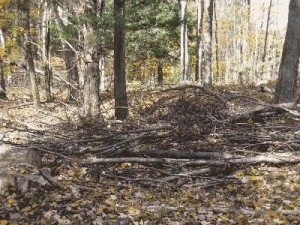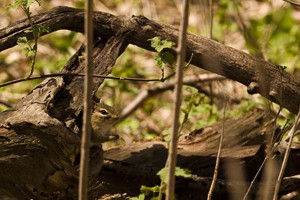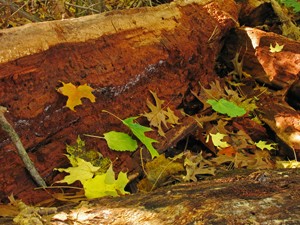
Coarse woody debris. To most people, two of the three words in that phrase have negative connotations. Debris is the worst offender, suggesting random junk strewn about. When the debris is coarse, it’s even worse – it’s unrefined, it’s big.
Coarse woody debris (CWD) is wood in the forest that’s no longer part of a living tree. Rather than being dead, this wood is an important source of life in the forest. Foresters who value it for its ecological functions have been searching for new terms for CWD, and you’ll hear it referred to as biomass, dead wood, coarse woody material, and even retained organic matter.
Harry Dwyer, a forester in Fayette, Maine, likens the language predicament to that of another formerly maligned material: garden waste. He said, “You could look at a pile of rotting vegetables as garbage, or you could note its value and call it compost.” Digging into a rotten log in his woodlot, Dwyer displays some of the dark, wet material in his hand. “It doesn’t matter what you call this – coarse woody debris, coarse woody material, or wildlife habitat – it still functions as a critical component of forest health. But the words we use do make a difference, particularly now that everyone is talking about removing biomass from the forest for fuel.”
Let’s call it coarse woody material or CWM.
When trees die on their own, they remain part of the forest community – as standing dead trees (snags), stumps, down logs, or fallen branches. This CWM is gradually broken down into smaller and smaller parts by fungi, insects, microorganisms, and bacteria, until it’s fully incorporated into the forest soil. Scientific research is gradually revealing the important role dead wood plays in forest ecosystems, from wildlife habitat to carbon storage, though anyone who has ever disturbed an old wood pile knows dead wood is alive with animals and plants. Moving an old log might reveal a black rat snake using it for a nest site, or searching the dead wood for dinner. Above the forest floor, snags are high-demand housing for wildlife. When a pileated woodpecker leaves a cavity in a dead tree, a whole host of animals – from other birds to squirrels to wasps to northern long-eared bats – might move in. Logs that fall in streams and rivers form critical aquatic habitat by ponding water and storing sediments. When water cascades over a fallen log, it can dig out a small pool that will shelter young trout.
That’s not all. Coarse woody material serves as a carbon sink (as much as six percent of the carbon stored in Northeastern forests is in dead wood); it also serves as a seed bed for trees and plants, a mulch layer, and a slow-release fertilizer. Decomposing fungi depend on dead wood for nutrients and moisture, and in turn many trees rely on mutualistic relationships with mycorrhizal fungi. Nitrogen fixation in CWM by microbes (both anaerobic and microaerophyllic bacteria) provides this important element in both terrestrial and aquatic ecosystems.
In general, northern forests have less dead wood in them now than they did before Europeans arrived. Old growth forests tend to have more logs, snags, and other dead wood than managed or younger forests. While dead wood accumulates in forests over time, it doesn’t last forever. On average, snags typically stand about 10 years, while fallen logs may last twice that long. Timber harvests tend to temporarily increase the amount of dead wood because branches and the unmerchantable parts of felled trees are left on the ground, and just the more valuable parts of a tree are removed.
While harvests may produce a large amount of dead wood in the short term, they can also result in fewer trees left to die and become dead wood in the future. Bill Keeton, a forest ecologist at the University of Vermont, advocates for a balance between removing the maximum volume of wood products and retaining some biomass to maintain the structural complexity of forest. To increase dead wood and other old-growth characteristics in younger forests, Keeton favors harvest prescriptions that include retaining all trees greater than 24 inches in diameter, releasing crowns to accelerate growth of larger trees, and girdling (or felling) diseased, dying, or poorly formed trees to create snags or down logs. This ecological forestry approach values dead wood left in the forest along with the timber taken out in a harvest.
European Roots of Forestry
Forestry in the United States was originally built on ideas imported from Europe in the early 1900s. When early foresters like Gifford Pinchot brought the foundation of scientific forestry over from France and Germany, they also brought an emphasis on the sustained yield of timber. Timber was the most important forest product in their minds, so it drove most decisions about forest management. Consequently, dead wood in the forest came to be considered “debris.” A dead tree on the ground was considered a waste of resources or a potential fire hazard.
Another theme of early European forestry, however, included a more holistic perspective. Forestry textbooks like those written by Heinrich Cotta in the first part of the nineteenth century, are distinctly different from the kind of forestry brought to America by Pinchot. Early pioneers like Cotta talked about using nature as the guide and practicing forestry that preserves the soil’s fertility.
It’s as if European forestry was packed up in crates for shipment over here but one was left behind on the dock. While Cotta’s perspective did not survive forestry’s initial translation to American soil, it has gradually returned to the profession in this country, aided by luminaries such as Aldo Leopold, Rachel Carson and E. O. Wilson. What was once considered debris is now valued for the carbon it stores, the wildlife habitat it provides, and the nutrients it holds.
At the same time, though, society increasingly has its eyes on wood that has little economic value but has great value as a fuel source. Low-value trees, slash, and tops are being heralded as “woody biomass,” a potentially important part of the solution to our dependence on fossil fuels.
Woody biomass has long been a useful, if under-utilized, by-product of forest management activities. Foresters and loggers have prided themselves on their ability to put much of a felled tree to use. But interest in removing woody biomass has recently accelerated because of the rising cost of other fuels, concerns about carbon emissions from fossil fuels, and risks in western states of catastrophic wildfires. For example, the U.S. Department of Energy has set a goal to increase biofuel use in the U.S. 25 times by 2030. While biomass can be produced agriculturally, much of the biomass to fuel this increase in renewable energy would come from forests. In fact, a U.S. Department of Energy report estimates that U.S. forests could yield 368 million dry tons of useable biomass per year.
So the forest-policy discussion of woody debris has become increasingly complex. On the one hand, optimizing the utilization of wood – a naturally renewable resource – can help replace our reliance on foreign oil and can be a substitute for oil and other fossil fuels, thus helping to combat global climate change. On the other hand, as the allure of using woody biomass for energy increases, the removal of additional biomass raises questions about how much wood can be taken from a forest before the forest suffers negative consequences.
When timber harvests remove whole trees for energy production, the risk of nutrient loss increases because more leaves and needles are removed from the forests. Foliage and small, fine branches contain much higher concentrations of nutrients than stem wood. Therefore, when entire trees are taken from the forest, there is a greater risk for nutrient depletion than from harvests in which just roundwood (tree stems or boles) is removed. Rather than using whole-tree chips, some wood-fired power plant operators have taken the step of buying roundwood and then chipping it at the plant or in concentration yards.
Because of concerns about how much and what kind of CWM is removed, some states have crafted guidelines to help direct timber harvesters. Minnesota, Missouri, and Pennsylvania have published guidelines that suggest how and how much woody biomass can be responsibly removed from forests. A recent experimental harvest on the Superior Nation Forest, in Minnesota, showed that when harvesters followed state biomass guidelines, there were adequate snags and coarse woody material left behind. A report on impacts of biomass harvesting from Massachusetts has good news about calcium, a particularly important soil nutrient. When only 50 percent of the biomass is removed, the current level of calcium would be replenished in 71 years.
A good general guideline for Northeastern forests comes from the Society for the Protection of New Hampshire Forests’ manual, Good Forestry in the Granite State: “Manage for coarse woody material by retaining material that currently exists and allowing its accumulation where it is currently missing.” The Forest Stewardship Council’s standard for green-certified forests in the Northeast includes a requirement that harvesting leave enough dead woody material to “provide nutrient capital and habitat.”
Forestry is a complex business, and our understanding of the forest system is constantly evolving. What’s the best use for dead wood, whether it’s known as coarse woody debris, coarse woody material, or just simply biomass? That is at the center of the debate among foresters and other land stewards over how to balance societal demands for wood products with the need to sustain forest ecosystems over the long haul.





